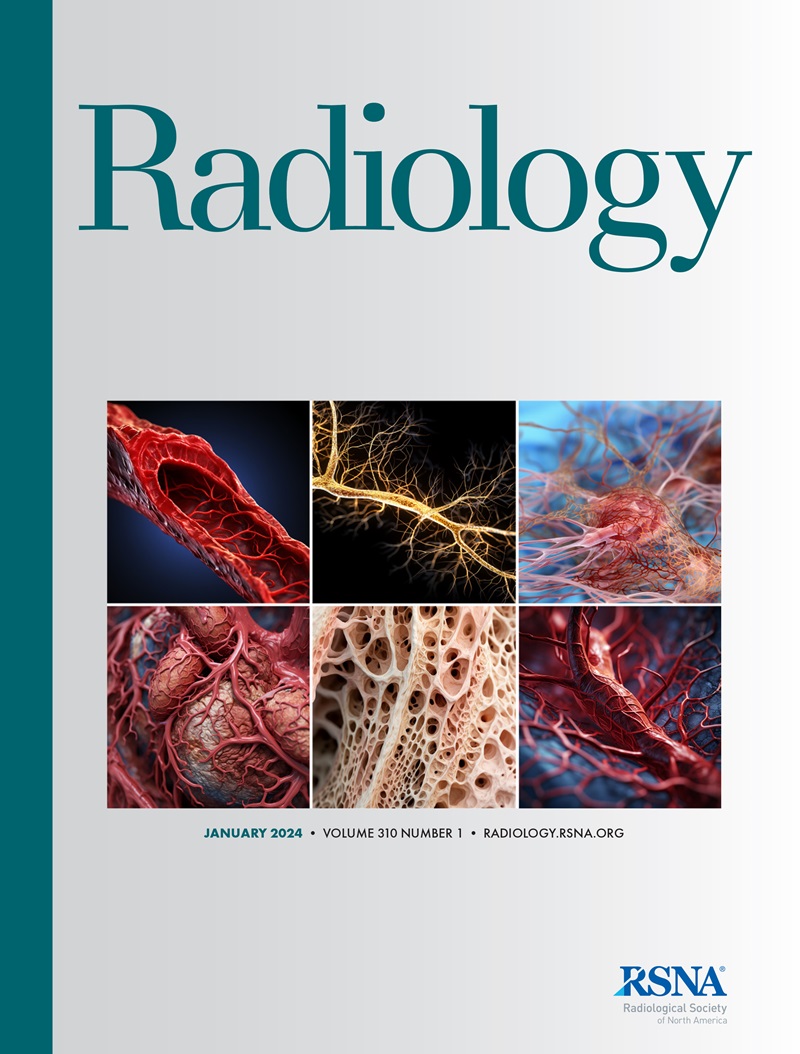Enhanced CT and MRI Focal Bone Tumor Classification with Machine Learning-based Stratification: A Multicenter Retrospective Study.
IF 12.1
1区 医学
Q1 RADIOLOGY, NUCLEAR MEDICINE & MEDICAL IMAGING
Astrée Lemore, Nora Vogt, Julien Oster, Edouard Germain, Marc Fauvel, Romain Gillet, François Sirveaux, Béatrice Marie, Nicolas Sans, Marie Faruch, Franck Lapègue, François Lafourcade, Sammy Badr, Anne Cotten, Fadila Mihoubi Bouvier, Sisi Yang, Jean-Luc Drapé, Maxime Pastor, Yann Thouvenin, Marie Pierre Baron, Catherine Cyteval, David Fadli, Claire Fournier, Olivier Hauger, Mariem Ben Haj Amor, Nicolas Stacoffe, Sophie Daubie, Jean-Baptiste Noel, Jean-Baptiste Pialat, Stéphane Cherix, Fabio Zanchi, Patrick Omoumi, Alain Blum, Gabriela Hossu, Pedro A Gondim Teixeira
求助PDF
{"title":"Enhanced CT and MRI Focal Bone Tumor Classification with Machine Learning-based Stratification: A Multicenter Retrospective Study.","authors":"Astrée Lemore, Nora Vogt, Julien Oster, Edouard Germain, Marc Fauvel, Romain Gillet, François Sirveaux, Béatrice Marie, Nicolas Sans, Marie Faruch, Franck Lapègue, François Lafourcade, Sammy Badr, Anne Cotten, Fadila Mihoubi Bouvier, Sisi Yang, Jean-Luc Drapé, Maxime Pastor, Yann Thouvenin, Marie Pierre Baron, Catherine Cyteval, David Fadli, Claire Fournier, Olivier Hauger, Mariem Ben Haj Amor, Nicolas Stacoffe, Sophie Daubie, Jean-Baptiste Noel, Jean-Baptiste Pialat, Stéphane Cherix, Fabio Zanchi, Patrick Omoumi, Alain Blum, Gabriela Hossu, Pedro A Gondim Teixeira","doi":"10.1148/radiol.232834","DOIUrl":null,"url":null,"abstract":"<p><p>Background Standardized bone tumor reporting is crucial for consistent, risk-aligned patient management. Current systems are based on expert consensus and/or lack multicenter validation. Purpose To evaluate a machine learning-based approach for differentiating between benign and malignant focal bone lesions and to propose a Bone Tumor Imaging Reporting and Data System (BTI-RADS) 2.0 for further risk stratification. Materials and Methods This retrospective multicenter trial included patients with solitary bone tumors undergoing <i>(a)</i> radiography or CT and <i>(b)</i> MRI at 10 centers from November 2009 to March 2022. Patients were divided into training and test datasets. Predefined radioclinical features were extracted. The training dataset was considered for bootstrapped χ<sup>2</sup> feature selection, and extreme gradient boosting (XGBoost) classifiers were optimized using nested cross-validation. Continuous classifier outputs were thresholded to stratify patients into seven malignancy risk classes (BTI-RADS 2.0), and malignancy rates were assessed for the test set. XGBoost and human expert performances were compared using the Wilcoxon signed-rank significance test with a significance level of .05. Results In total, 1113 patients (mean age, 39 years ± 22 [SD]; 623 men) were included: 298 in the training and 815 in the test datasets. Twenty-seven of 80 (34%) multimodal features were selected based on χ<sup>2</sup> analysis. Best classification performances were achieved by an XGBoost model trained on 27 features, with an F1 score of 0.81 (95% CI: 0.78, 0.84). This model performed slightly inferior to 28 experienced radiologists, who demonstrated an F1 score of 0.83 (95% CI: 0.80, 0.85; <i>P</i> < .001). BTI-RADS 2.0 risk grades II-V were associated with malignancy rates of 0% (0 of 102; 95% CI: 0, 0), 8.3% (14 of 168; 95% CI: 4, 13), 45% (121 of 271; 95% CI: 39, 50), and 92% (252 of 274; 95% CI: 89, 95), respectively, identifying malignant lesions with a sensitivity of 96% (373 of 387; 95% CI: 94, 98). Conclusion A machine learning algorithm and risk stratification system achieved accurate and standardized bone tumor malignancy grading. Clinical trial registration no. NCT04884048 © RSNA, 2025 <i>Supplemental material is available for this article.</i> See also the editorial by Tordjman and Murphey in this issue.</p>","PeriodicalId":20896,"journal":{"name":"Radiology","volume":"315 1","pages":"e232834"},"PeriodicalIF":12.1000,"publicationDate":"2025-04-01","publicationTypes":"Journal Article","fieldsOfStudy":null,"isOpenAccess":false,"openAccessPdf":"","citationCount":"0","resultStr":null,"platform":"Semanticscholar","paperid":null,"PeriodicalName":"Radiology","FirstCategoryId":"3","ListUrlMain":"https://doi.org/10.1148/radiol.232834","RegionNum":1,"RegionCategory":"医学","ArticlePicture":[],"TitleCN":null,"AbstractTextCN":null,"PMCID":null,"EPubDate":"","PubModel":"","JCR":"Q1","JCRName":"RADIOLOGY, NUCLEAR MEDICINE & MEDICAL IMAGING","Score":null,"Total":0}
引用次数: 0
引用
批量引用
Abstract
Background Standardized bone tumor reporting is crucial for consistent, risk-aligned patient management. Current systems are based on expert consensus and/or lack multicenter validation. Purpose To evaluate a machine learning-based approach for differentiating between benign and malignant focal bone lesions and to propose a Bone Tumor Imaging Reporting and Data System (BTI-RADS) 2.0 for further risk stratification. Materials and Methods This retrospective multicenter trial included patients with solitary bone tumors undergoing (a) radiography or CT and (b) MRI at 10 centers from November 2009 to March 2022. Patients were divided into training and test datasets. Predefined radioclinical features were extracted. The training dataset was considered for bootstrapped χ2 feature selection, and extreme gradient boosting (XGBoost) classifiers were optimized using nested cross-validation. Continuous classifier outputs were thresholded to stratify patients into seven malignancy risk classes (BTI-RADS 2.0), and malignancy rates were assessed for the test set. XGBoost and human expert performances were compared using the Wilcoxon signed-rank significance test with a significance level of .05. Results In total, 1113 patients (mean age, 39 years ± 22 [SD]; 623 men) were included: 298 in the training and 815 in the test datasets. Twenty-seven of 80 (34%) multimodal features were selected based on χ2 analysis. Best classification performances were achieved by an XGBoost model trained on 27 features, with an F1 score of 0.81 (95% CI: 0.78, 0.84). This model performed slightly inferior to 28 experienced radiologists, who demonstrated an F1 score of 0.83 (95% CI: 0.80, 0.85; P < .001). BTI-RADS 2.0 risk grades II-V were associated with malignancy rates of 0% (0 of 102; 95% CI: 0, 0), 8.3% (14 of 168; 95% CI: 4, 13), 45% (121 of 271; 95% CI: 39, 50), and 92% (252 of 274; 95% CI: 89, 95), respectively, identifying malignant lesions with a sensitivity of 96% (373 of 387; 95% CI: 94, 98). Conclusion A machine learning algorithm and risk stratification system achieved accurate and standardized bone tumor malignancy grading. Clinical trial registration no. NCT04884048 © RSNA, 2025 Supplemental material is available for this article. See also the editorial by Tordjman and Murphey in this issue.
基于机器学习分层的增强CT和MRI局灶性骨肿瘤分类:一项多中心回顾性研究。
标准化骨肿瘤报告对于一致的、风险一致的患者管理至关重要。目前的系统是基于专家共识和/或缺乏多中心验证。目的评估一种基于机器学习的方法来区分良性和恶性局灶性骨病变,并提出骨肿瘤成像报告和数据系统(BTI-RADS) 2.0,以进一步进行风险分层。材料和方法本回顾性多中心试验纳入了2009年11月至2022年3月在10个中心接受(a) x线摄影或CT和(b) MRI检查的孤立性骨肿瘤患者。将患者分为训练数据集和测试数据集。提取预定义的放射临床特征。将训练数据集用于bootstrap χ2特征选择,并使用嵌套交叉验证优化极端梯度增强(XGBoost)分类器。连续分类器输出的阈值将患者分为7个恶性肿瘤风险等级(BTI-RADS 2.0),并对测试集的恶性肿瘤率进行评估。使用显著性水平为0.05的Wilcoxon符号秩显著性检验比较XGBoost和人类专家的表现。结果共1113例患者(平均年龄39岁±22岁[SD];623名男性)被纳入:298名在训练数据集,815名在测试数据集。根据χ2分析,从80个多模式特征中选出27个(34%)。在27个特征上训练的XGBoost模型获得了最好的分类性能,F1得分为0.81 (95% CI: 0.78, 0.84)。该模型的表现略低于28名经验丰富的放射科医生,他们的F1评分为0.83 (95% CI: 0.80, 0.85;P < 0.001)。BTI-RADS 2.0风险等级II-V与恶性肿瘤发生率相关为0% (0 / 102;95% CI: 0,0), 8.3%(168例中14例;95% CI: 4,13), 45%(271人中有121人;95% CI: 39,50)和92% (252 / 274;95% CI: 89,95),识别恶性病变的敏感性为96%(387例中有373例;95% ci: 94,98)。结论机器学习算法和风险分层系统实现了准确、规范的骨肿瘤恶性分级。临床试验注册号:NCT04884048©RSNA, 2025本文提供补充材料。参见本期Tordjman和murphy的社论。
本文章由计算机程序翻译,如有差异,请以英文原文为准。

 求助内容:
求助内容: 应助结果提醒方式:
应助结果提醒方式:


